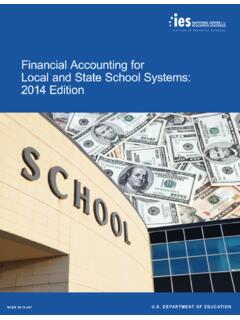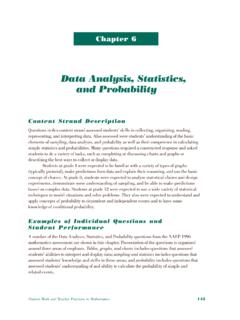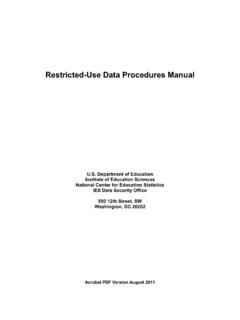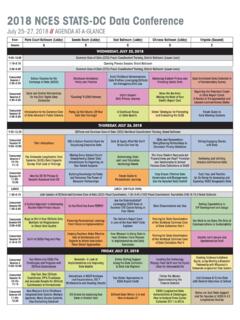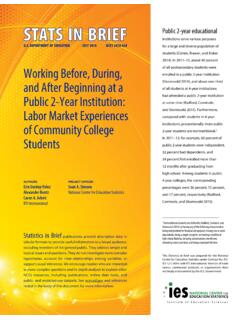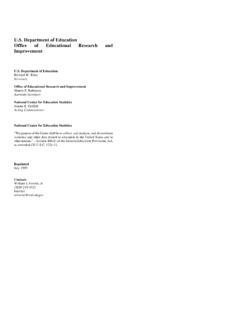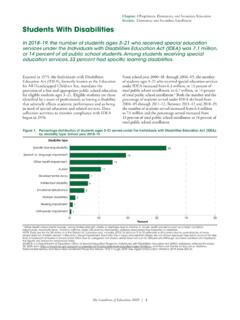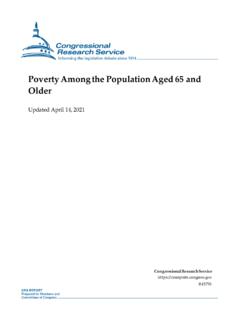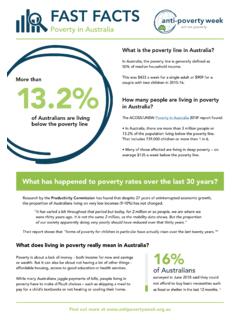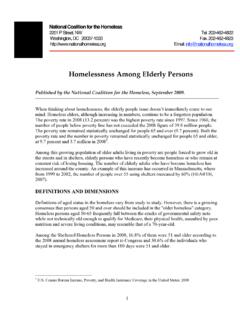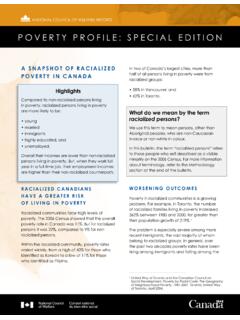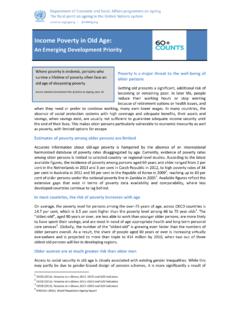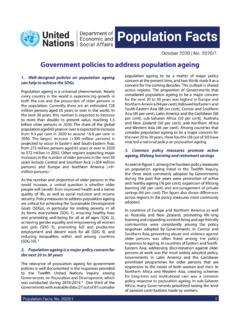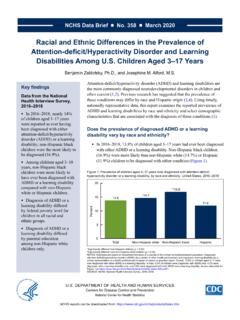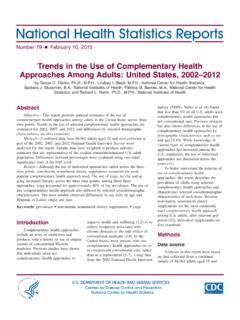Transcription of Status and Trends in the Education of Racial and Ethnic ...
1 Status and Trends in the Education of Racial and Ethnic Groups 2016 NCES DEPARTMENT OF EDUCATIONS tatus and Trends in the Education of Racial and Ethnic Groups 2016 AUGUST 2016 Lauren Musu-GilletteJennifer RobinsonJoel McFarlandNational Center for Education StatisticsAngelina KewalRamaniAnlan ZhangSidney Wilkinson-FlickerAmerican Institutes for ResearchNCES DEPARTMENT OF Department of Education John B. King, Jr. SecretaryInstitute of Education Sciences Ruth Neild Deputy Director for Policy and Research Delegated Duties of the DirectorNational Center for Education Statistics Peggy G. Carr Acting CommissionerThe National Center for Education Statistics (NCES) is the primary federal entity for collecting, analyzing, and reporting data related to Education in the United States and other nations.
2 It fulfills a congressional mandate to collect, collate, analyze, and report full and complete statistics on the condition of Education in the United States; conduct and publish reports and specialized analyses of the meaning and significance of such statistics; assist state and local Education agencies in improving their statistical systems; and review and report on Education activities in foreign activities are designed to address high-priority Education data needs; provide consistent, reliable, complete, and accurate indicators of Education Status and Trends ; and report timely, useful, and high-quality data to the Department of Education , the Congress, the states, other Education policymakers, practitioners, data users, and the general public.
3 Unless specifically noted all information contained herein is in the public strive to make our products available in a variety of formats and in language that is appropriate to a variety of audiences. You, as our customer, are the best judge of our success in communicating information effectively. If you have any comments or suggestions about this or any other NCES product or report, we would like to hear from you. Please direct your comments toNCES, IES, Department of Education Potomac Center Plaza (PCP) 550 12th Street SW Washington, DC 20202 Aug ust 2016 The NCES Home Page address is The NCES Publications and Products address is publication is only available online. To download, view, and print the report as a PDF file, go to the NCES Publications and Products address shown report was prepared for the National Center for Education Statistics under Contract No.
4 ED-IES-12-D-0002 with American Institutes for Research. Mention of trade names, commercial products, or organizations does not imply endorsement by the Citation Musu-Gillette, L., Robinson, J., McFarland, J., KewalRamani, A., Zhang, A., and Wilkinson-Flicker, S. (2016). Status and Trends in the Education of Racial and Ethnic Groups 2016 (NCES 2016-007). Department of Education , National Center for Education Statistics. Washington, DC. Retrieved [date] from Contact Lauren Musu-Gillette (202) 245-7045 Highlights Status and Trends in the Education of Racial and Ethnic Groups examines the educational progress and challenges students face in the United States by race/ethnicity. This report shows that over time, students in the Racial / Ethnic groups of White, Black, Hispanic, Asian, Native Hawaiian or Other Pacific Islander, American Indian/Alaska Native, and Two or more races have completed high school and continued their Education in college in increasing numbers.
5 Despite these gains, the rate of progress has varied among these Racial / Ethnic groups and differences by race/ethnicity persist in terms of increases in attainment and progress on key indicators of educational performance. Demographics: The percentage of school-age children ages 5 17 in the United States who were White decreased from 62 percent in 2000 to 53 percent in 2013, and the percentage of children who were Black decreased from 15 to 14 percent during this time. In contrast, the percentage of school-age children who were from other Racial / Ethnic groups increased during this period: those who were Hispanic increased from 16 to 24 percent; those who were Asian, from 3 to 5 percent; and those who were of Two or more races, from 2 to 4 percent.
6 (Indicator 1). In 2013, the percentage of all children under 18 who were born within the United States was 97 percent. The percentages of Asian, Pacific Islander, and Hispanic children who were born within the United States (79, 93, and 94 percent, respectively) were below the 97 percent average for all children. In contrast, the percentages of Black children ( percent), White children and children of Two or more races (99 percent each), and American Indian/Alaska Native children (rounds to 100 percent) who were born within the United States were above the average for all children. (Indicator 2). Greater percentages of Asian and Hispanic children under 18 were born within the United States in 2013 than in 2003 (79 vs.)
7 77 percent for Asian children and 94 vs. 89 percent for Hispanic children). (Indicator 2). In 2013, a higher percentage of Asian children (83 percent) lived with married parents than did White children (73 percent), Pacific Islander children (60 percent), Hispanic children and children of Two of more races (57 percent each), American Indian/Alaska Native children (44 percent), and Black children (32 percent). (Indicator 3). The percentage of children under age 18 living in poverty , based on the official poverty measure, varied across Racial / Ethnic groups. In 2013, the percentage was highest for Black children (39 percent), followed by Hispanic children (30 percent), and White and Asian children (10 percent for each).
8 (Indicator 4).Preprimary, Elementary, and Secondary Education Participation: In 2012, about 28 percent of children under 6 years old who were not enrolled in kindergarten regularly received center-based care. The percentage of children who regularly received center-based care was higher for Black (34 percent), Asian (33 percent), and White children (29 percent) than for Hispanic children (22 percent). (Indicator 5). In 2012, a higher percentage of young children from nonpoor families than from poor families regularly received center-based care (34 vs. 20 percent). This same pattern was observed for White, Black, and Hispanic young children. (Indicator 5). Between fall 2002 and fall 2012, the percentage of students enrolled in public elementary and secondary schools who were White decreased from 59 to 51 percent, and the percentage who were Black decreased from 17 to 16 percent.
9 During the same period, however, the percentage who were Hispanic increased from 18 to 24 percent, and the percentage who were Asian/Pacific Islander increased from 4 to 5 percent. (Indicator 6). Black students accounted for a higher percentage of enrollment in public charter schools (28 percent) than in traditional public schools (15 percent) in 2012. Hispanic students also accounted for a higher percentage of enrollment in public charter schools (29 percent) than in traditional public schools (24 percent). The percentage of public charter school enrollees who were White (35 percent) was lower than the percentage of traditional public school enrollees who were White (52 percent). Asian/Pacific Islander students also made up a lower percentage of charter school enrollees (4 percent) than of traditional public school enrollees (5 percent).
10 (Indicator 6). In 2013, about million public school students participated in English language learner (ELL) programs. Hispanic students made up the majority of this group (78 percent), with around million participating in ELL programs. (Indicator 7).Highlightsiii The ELL program participation rate in 2013 for some Racial / Ethnic groups was lower than the total participation rate (9 percent). About 7 percent of American Indian/Alaska Native students, 2 percent of Black students, 2 percent of students of Two or more races, and 1 percent of White students participated in ELL programs. In contrast, the percentages of Hispanic (29 percent), Asian (20 percent), and Pacific Islander (14 percent) students participating in ELL programs were higher than the total percentage in 2013.
